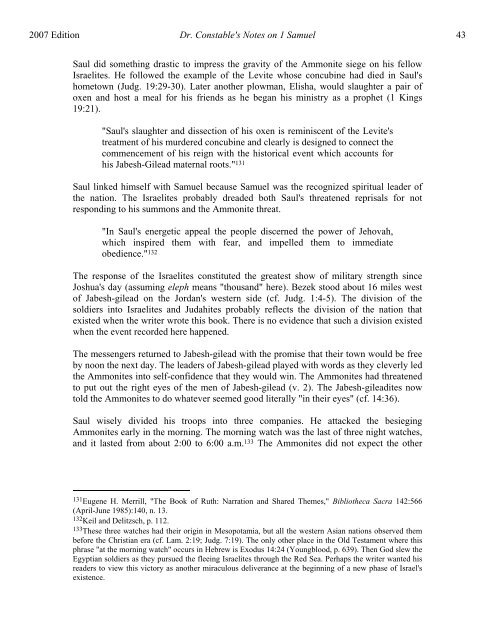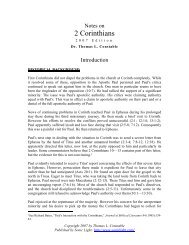1 Samuel - Odessa, Missouri Community of Christ
1 Samuel - Odessa, Missouri Community of Christ
1 Samuel - Odessa, Missouri Community of Christ
You also want an ePaper? Increase the reach of your titles
YUMPU automatically turns print PDFs into web optimized ePapers that Google loves.
2007 Edition Dr. Constable's Notes on 1 <strong>Samuel</strong> 43Saul did something drastic to impress the gravity <strong>of</strong> the Ammonite siege on his fellowIsraelites. He followed the example <strong>of</strong> the Levite whose concubine had died in Saul'shometown (Judg. 19:29-30). Later another plowman, Elisha, would slaughter a pair <strong>of</strong>oxen and host a meal for his friends as he began his ministry as a prophet (1 Kings19:21)."Saul's slaughter and dissection <strong>of</strong> his oxen is reminiscent <strong>of</strong> the Levite'streatment <strong>of</strong> his murdered concubine and clearly is designed to connect thecommencement <strong>of</strong> his reign with the historical event which accounts forhis Jabesh-Gilead maternal roots." 131Saul linked himself with <strong>Samuel</strong> because <strong>Samuel</strong> was the recognized spiritual leader <strong>of</strong>the nation. The Israelites probably dreaded both Saul's threatened reprisals for notresponding to his summons and the Ammonite threat."In Saul's energetic appeal the people discerned the power <strong>of</strong> Jehovah,which inspired them with fear, and impelled them to immediateobedience." 132The response <strong>of</strong> the Israelites constituted the greatest show <strong>of</strong> military strength sinceJoshua's day (assuming eleph means "thousand" here). Bezek stood about 16 miles west<strong>of</strong> Jabesh-gilead on the Jordan's western side (cf. Judg. 1:4-5). The division <strong>of</strong> thesoldiers into Israelites and Judahites probably reflects the division <strong>of</strong> the nation thatexisted when the writer wrote this book. There is no evidence that such a division existedwhen the event recorded here happened.The messengers returned to Jabesh-gilead with the promise that their town would be freeby noon the next day. The leaders <strong>of</strong> Jabesh-gilead played with words as they cleverly ledthe Ammonites into self-confidence that they would win. The Ammonites had threatenedto put out the right eyes <strong>of</strong> the men <strong>of</strong> Jabesh-gilead (v. 2). The Jabesh-gileadites nowtold the Ammonites to do whatever seemed good literally "in their eyes" (cf. 14:36).Saul wisely divided his troops into three companies. He attacked the besiegingAmmonites early in the morning. The morning watch was the last <strong>of</strong> three night watches,and it lasted from about 2:00 to 6:00 a.m. 133 The Ammonites did not expect the other131 Eugene H. Merrill, "The Book <strong>of</strong> Ruth: Narration and Shared Themes," Bibliotheca Sacra 142:566(April-June 1985):140, n. 13.132 Keil and Delitzsch, p. 112.133 These three watches had their origin in Mesopotamia, but all the western Asian nations observed thembefore the <strong>Christ</strong>ian era (cf. Lam. 2:19; Judg. 7:19). The only other place in the Old Testament where thisphrase "at the morning watch" occurs in Hebrew is Exodus 14:24 (Youngblood, p. 639). Then God slew theEgyptian soldiers as they pursued the fleeing Israelites through the Red Sea. Perhaps the writer wanted hisreaders to view this victory as another miraculous deliverance at the beginning <strong>of</strong> a new phase <strong>of</strong> Israel'sexistence.








